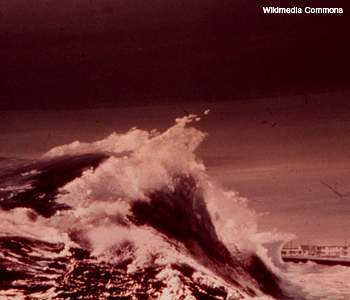Scatterings
Deciphering Rogue Waves
A team of researchers from Spain, France and Brazil found a way to generate rogue waves and developed a model for understanding them as a result of a deterministic nonlinear process.
 Rogue waves, whether in the semiconductor laser system or on the ocean, are much larger than surrounding waves.
Rogue waves, whether in the semiconductor laser system or on the ocean, are much larger than surrounding waves.
Rare pulses with giant intensities—the optical equivalent of rogue ocean waves—have been shown to occur in common laser systems. A team of researchers from Spain, France and Brazil found a way to generate rogue waves and developed a model for understanding them as a result of a deterministic nonlinear process (Phys. Rev. Lett. 107, 053901). Extremely high waves have been a subject of interest over the past decade in oceanography as well as in other fields (including optics), but we still don’t fully understand what triggers them and how they develop.
…Log in or become a member to view the full text of this article.
This article may be available for purchase via the search at Optica Publishing Group.
Optica Members get the full text of Optics & Photonics News, plus a variety of other member benefits.
